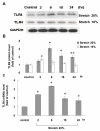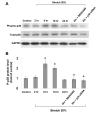Cyclic stretch enhances the expression of toll-like receptor 4 gene in cultured cardiomyocytes via p38 MAP kinase and NF-kappaB pathway
- PMID: 20202224
- PMCID: PMC2844375
- DOI: 10.1186/1423-0127-17-15
Cyclic stretch enhances the expression of toll-like receptor 4 gene in cultured cardiomyocytes via p38 MAP kinase and NF-kappaB pathway
Abstract
Background: Toll-like receptor 4 (TLR4) plays an important role in innate immunity. The role of TLR4 in stretched cardiomyocytes is not known. We sought to investigate whether mechanical stretch could regulate TLR4 expression, as well as the possible molecular mechanisms and signal pathways mediating the expression of TLR4 by cyclic mechanical stretch in cardiomyocytes.
Methods: Neonatal Wistar rat cardiomyocytes grown on a flexible membrane base were stretched by vacuum to 20% of maximum elongation at 60 cycles/min. Western blot, real-time polymerase chain reaction, and promoter activity assay were performed. In vitro monocyte adhesion to stretched myocyte was detected.
Results: Cyclic stretch significantly increased TLR4 protein and mRNA expression after 2 h to 24 h of stretch. Addition of SB203580, TNF-alpha antibody, and p38alpha MAP kinase siRNA 30 min before stretch inhibited the induction of TLR4 protein. Cyclic stretch increased, while SB203580 abolished the phosphorylated p38 protein. Gel shifting assay showed significant increase of DNA-protein binding activity of NF-kappaB after stretch and SB203580 abolished the DNA-protein binding activity induced by cyclic stretch. DNA-binding complexes induced by cyclic stretch could be supershifted by p65 monoclonal antibody. Cyclic stretch increased TLR4 promoter activity while SB203580 and NF-kappaB siRNA decreased TLR4 promoter activity. Cyclic stretch increased adhesion of monocyte to cardiomyocytes while SB203580, TNF-alpha antibody, and TLR4 siRNA attenuated the adherence of monocyte. TNF-alpha and Ang II significantly increased TLR4 protein expression. Addition of losartan, TNF-alpha antibody, or p38alpha siRNA 30 min before Ang II and TNF-alpha stimulation significantly blocked the increase of TLR4 protein by AngII and TNF-alpha.
Conclusions: Cyclic mechanical stretch enhances TLR4 expression in cultured rat neonatal cardiomyocytes. The stretch-induced TLR4 is mediated through activation of p38 MAP kinase and NF-kappaB pathways. TLR4 up-regulation by cyclic stretch increases monocyte adherence.
Figures








Similar articles
-
Mechanical stretch enhances the expression of resistin gene in cultured cardiomyocytes via tumor necrosis factor-alpha.Am J Physiol Heart Circ Physiol. 2007 Oct;293(4):H2305-12. doi: 10.1152/ajpheart.00361.2007. Epub 2007 Jun 15. Am J Physiol Heart Circ Physiol. 2007. PMID: 17573461
-
Insulin-like growth factor-1 mediates stretch-induced upregulation of myostatin expression in neonatal rat cardiomyocytes.Cardiovasc Res. 2005 Dec 1;68(3):405-14. doi: 10.1016/j.cardiores.2005.06.028. Epub 2005 Aug 25. Cardiovasc Res. 2005. PMID: 16125157
-
Regulation of GADD153 induced by mechanical stress in cardiomyocytes.Eur J Clin Invest. 2009 Nov;39(11):960-71. doi: 10.1111/j.1365-2362.2009.02193.x. Epub 2009 Jul 9. Eur J Clin Invest. 2009. PMID: 19614958
-
Chlamydophila pneumoniae induces expression of toll-like receptor 4 and release of TNF-alpha and MIP-2 via an NF-kappaB pathway in rat type II pneumocytes.Respir Res. 2005 Jun 3;6(1):51. doi: 10.1186/1465-9921-6-51. Respir Res. 2005. PMID: 15935092 Free PMC article.
-
Dependence on p38 MAPK signalling in the up-regulation of TLR2, TLR4 and TLR9 gene expression in Trichomonas vaginalis-treated HeLa cells.Immunology. 2006 Jun;118(2):164-70. doi: 10.1111/j.1365-2567.2006.02347.x. Immunology. 2006. PMID: 16771851 Free PMC article.
Cited by
-
NAMPT and BMAL1 Are Independently Involved in the Palmitate-Mediated Induction of Neuroinflammation in Hypothalamic Neurons.Front Endocrinol (Lausanne). 2020 Jun 12;11:351. doi: 10.3389/fendo.2020.00351. eCollection 2020. Front Endocrinol (Lausanne). 2020. PMID: 32595600 Free PMC article.
-
Microfluidic endothelial cell culture model to replicate disturbed flow conditions seen in atherosclerosis susceptible regions.Biomicrofluidics. 2011 Sep;5(3):32006-3200611. doi: 10.1063/1.3608137. Epub 2011 Sep 20. Biomicrofluidics. 2011. PMID: 22662029 Free PMC article.
-
Cilostazol disrupts TLR-4, Akt/GSK-3β/CREB, and IL-6/JAK-2/STAT-3/SOCS-3 crosstalk in a rat model of Huntington's disease.PLoS One. 2018 Sep 27;13(9):e0203837. doi: 10.1371/journal.pone.0203837. eCollection 2018. PLoS One. 2018. PMID: 30260985 Free PMC article.
-
Cyclic stretch induced IL-33 production through HMGB1/TLR-4 signaling pathway in murine respiratory epithelial cells.PLoS One. 2017 Sep 12;12(9):e0184770. doi: 10.1371/journal.pone.0184770. eCollection 2017. PLoS One. 2017. PMID: 28898270 Free PMC article.
-
Mechanobiological Principles Influence the Immune Response in Regeneration: Implications for Bone Healing.Front Bioeng Biotechnol. 2021 Feb 12;9:614508. doi: 10.3389/fbioe.2021.614508. eCollection 2021. Front Bioeng Biotechnol. 2021. PMID: 33644014 Free PMC article. Review.
References
Publication types
MeSH terms
Substances
LinkOut - more resources
Full Text Sources
Molecular Biology Databases
Miscellaneous

